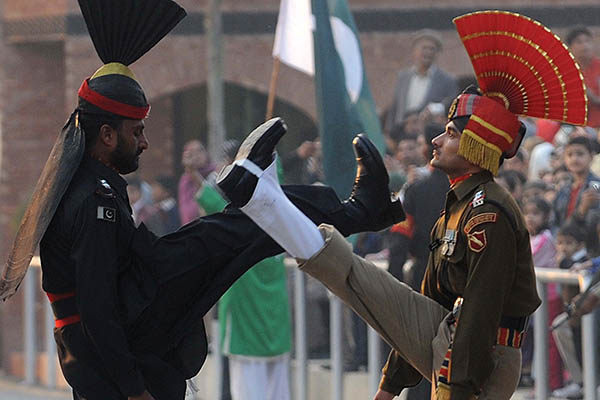
File photo of Pakistani Rangers and Indian Border Security Force personnel on the Pakistan-India Border at Wagah. Narinder Naru—AFP
Rumors of peace are flying around even as competing states in the South Asian region give no clear signs of living in amity. A recent news item claimed India and China were waking up to the advantages of living in peace, even as Indian observers believe that every time Delhi patches up with Beijing on border issues, it comes out short-changed in the bargain. There are finally also rumors of peace between India and Pakistan and the opening-up of a trading relationship, which is much in need. There was a time when the neighboring nations actually traded amid plaints by some Indian businessmen that doing trade with Pakistan raised suspicion within the security establishment and triggered interrogations about transactions. Up till the 1960s, coal from India and jute from then-East Pakistan were traded between the two. But war was preferred in 1965 and trade was formally suspended till 1974, to begin once again in 1976, with Pakistan even participating in a trade fair held in New Delhi in 1981.
But fighting continued to take preference. After the 1965 War came a trade embargo that lasted till 1974. In 1976, Pakistan allowed its private sector to directly trade with India. Then in 1981, Pakistan took part in the International Trade Fair in Delhi and started the process of trade delegations from the two countries visiting each other. In 1986, India and Pakistan joined the South Asian Association for Regional Cooperation (SAARC), committed to the welfare of the people of the region. In 1989, Pakistan agreed to import 322 Indian items. Then-prime minister Nawaz Sharif in 1991 also gave a push to Pak-Indo trade and in December 1995, the South Asian Preferential Trading Arrangement (SAPTA) was signed, giving a boost for the development of bilateral trade between the neighbors. At the end of three rounds of trade negotiations, a total of 5,550 items were considered for tariff concessions.
Writing in daily Dawn recently, Indian columnist Jawed Naqvi actually thought something was on the cards given a statement by P.M. Shehbaz Sharif that he wanted normalization of relations with India. He opined that since the Indian and Pakistani prime ministers would be in Samarkand soon to participate in a two-day summit of the Shanghai Cooperation Organization (SCO), something pleasant might happen. Sad to say, nothing did. We know that Samarkand has a history of nudging India and Pakistan to terminate their mistrust. The 1965 Tashkent Agreement did bring closure to a needless war between the two neighbors, but things rolled back to the more familiar state of conflict. Not to forget that the SCO’s next session would be held in India in 2023 and Narendra Modi would not have forgotten Sharif’s statement hoping for normalization. Unfortunately, war rather than peace is more normal in the conduct of relations between the two states actually needing peace to manage the consequences of global warming and increasing tendency on the part of pressured states to go to war.
